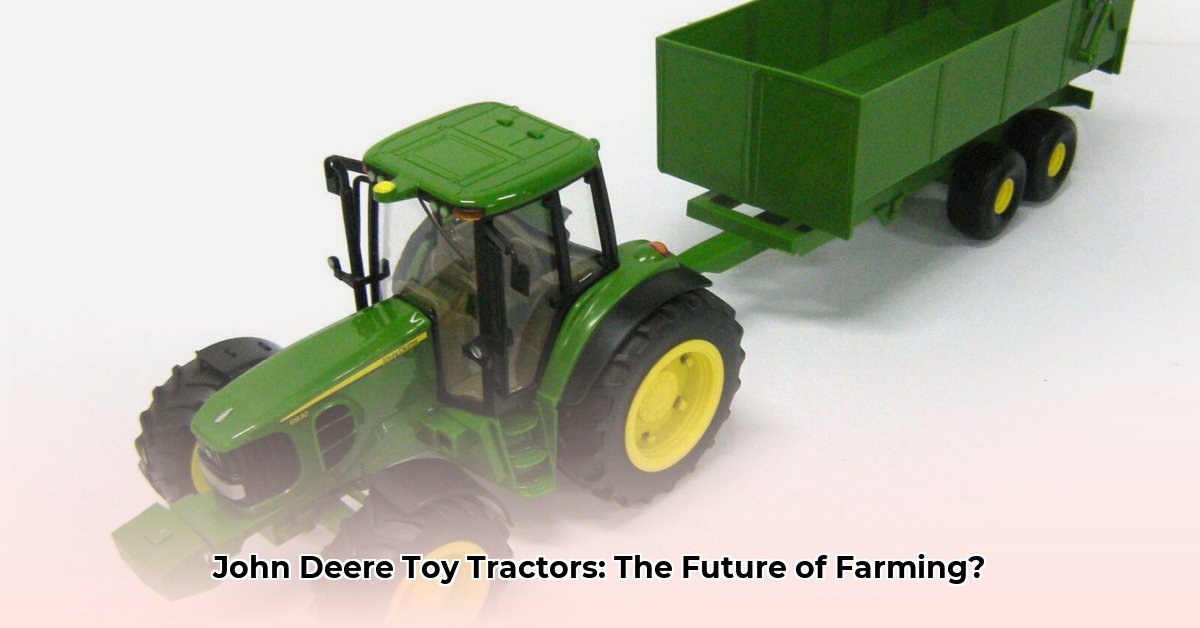
John Deere's Sustainability Journey: From Toy Tractors to Transformative Technology
John Deere. The name evokes images of powerful farm machinery and the backbone of modern agriculture. But the story of John Deere, from its iconic green and yellow toys to its massive, real-world equipment, is about more than just farming; it's a story of sustainability and the choices that will shape tomorrow's food supply and our planet. This article explores John Deere's role in this story, examining its progress, its challenges, and the future of sustainable agriculture. Learn more about the history of John Deere's miniature toy tractors here.
From Playthings to Ponderings: Sustainability’s Small Scale and Grand Ambitions
A child's bright red John Deere toy tractor wagon embodies the larger conversation around sustainable agriculture. While seemingly insignificant, its creation – from raw materials to manufacturing and packaging – has an environmental footprint. This raises crucial questions: are the plastics recycled? Is the production energy-efficient? Are sustainable materials utilized? While John Deere has made strides in its larger equipment, the sustainability story for smaller products remains less clear. This lack of transparency underscores the need for a holistic approach to sustainability across the entire product lifecycle.
John Deere's Sustainability Initiatives: Progress and Persistent Challenges
John Deere faces growing pressure to operate more sustainably. This involves responsible resource management, from material sourcing to product disposal. The company has launched several sustainability programs, yet the full impact is still evolving. While improvements in fuel efficiency for larger machinery are noteworthy, the broader use of sustainable materials across the entire product line requires further attention. Experts suggest that while initiatives like reducing greenhouse gas emissions by 29% since 2017 (per their 2022 Sustainability Report) are impressive, a comprehensive assessment requires examining the entire product lifecycle – from manufacturing to disposal. This involves understanding the environmental impact that goes beyond the initial operational metrics.
Stakeholder Perspectives: A Collaborative Path Forward
The journey towards sustainable farming requires collaboration among several key players:
John Deere: Balancing profitability with environmental responsibility is crucial. Short-term profits might incentivize less sustainable choices, but long-term considerations—including consumer and regulatory pressures—demand a shift towards sustainable practices.
Farmers: The immediate need is for affordable and reliable machinery. Sustainable equipment might have higher upfront costs, creating affordability challenges for farmers with limited budgets. Bridging this gap is essential for wider adoption.
Consumers: Increasing consumer awareness of environmental impact drives demand for sustainably produced goods and transparent manufacturing processes. Consumers are increasingly conscious of a company's environmental footprint and actively seek products from organizations with strong sustainability commitments.
Governments and NGOs: Regulations and financial incentives from governments and NGOs are vital in driving industry-wide change. Subsidies for sustainable farming methods and stricter environmental laws are shaping the agricultural landscape. Furthermore, efficient regulatory measures and support for research and development are essential.
A Roadmap for Sustainable Farming: Actionable Steps
Invest in R&D: Developing and implementing sustainable materials throughout the entire product line (from the largest combine to the smallest toy tractor) is key. This includes exploring bio-based plastics and increasing the use of recycled materials.
Optimize Manufacturing: Implementing lean manufacturing principles, improving energy efficiency, and exploring closed-loop systems where waste from one stage becomes input for another are essential. This encompasses reducing waste and improving resource efficiency.
Promote Responsible Disposal: Creating robust end-of-life management programs – including recycling or upcycling – is paramount to reduce the number of agricultural machines ending up in landfills.
Transparency and Communication: Open and honest communication with consumers about sustainability efforts builds trust and confidence, demonstrating corporate accountability and responsibility.
Collaboration: Open collaboration between John Deere, farmers, governments, and NGOs is essential to create effective and widely adopted solutions, fostering a cooperative environment to develop and implement strategies.
Navigating the Risks: Challenges and Opportunities
Challenges remain. The short-term costs of adopting sustainable practices might outweigh perceived immediate benefits. Sourcing sufficient sustainable materials to meet demand could also pose difficulties. However, overcoming these risks presents opportunities for innovation and competitive advantage. Companies leading in sustainability are likely to attract environmentally conscious customers. A proactive approach to risk assessment and mitigation, including contingency planning and alternative strategies, is therefore crucial.
The Future is Green: A Shared Vision for Sustainable Agriculture
The journey towards sustainable agriculture needs a coordinated effort: a commitment to innovation, transparency, and responsible stewardship of our planet's resources. While the path presents challenges, the goal – a future where farming sustainably nourishes both people and the planet – remains clear. John Deere, along with other stakeholders, has a significant role to play in achieving this shared vision for a more sustainable future.
Key Takeaways:
John Deere has made noteworthy progress in some areas of sustainability, including fuel efficiency improvements and waste reduction. These initiatives demonstrate a commitment to sustainability but also highlight areas for improvement and further action.
Technologies like See & Spray Ultimate and ExactShot show promise for reducing resource use, yet their widespread adoption by farmers depends on various factors, including affordability and training.
A truly comprehensive assessment of John Deere’s environmental impact requires examining the entire product lifecycle, including manufacturing, transportation, and disposal, going beyond solely the company's reported operational metrics.
Collaboration between John Deere, farmers, governments, and consumers is essential to overcome challenges and achieve sustainable agriculture. Open communication and shared responsibility are paramount in achieving mutual goals.
Proactive risk assessment and mitigation strategies are crucial to navigate potential obstacles and seize opportunities in the transition towards sustainable agricultural practices.